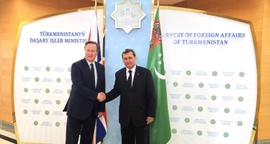The recent decision made jointly by Riyadh and Moscow has pushed the benchmark Brent crude price above the $90 per barrel threshold in Tuesday’s trading session, marking a price level not seen in the market since November.
On Tuesday, the governments of Russia and Saudi Arabia reached an agreement to extend their voluntary oil production cuts until the end of this year, with the aim of supporting the stability and balance of oil markets.
Russian Deputy Prime Minister Alexander Novak revealed Moscow’s plan to reduce oil exports by 300,000 barrels per day (bpd) throughout the rest of 2023.
“The additional voluntary reduction of oil supplies for export is aimed at strengthening the precautionary measures taken by OPEC+ countries in order to maintain the stability and balance of oil markets,” Vedomosti quoted Novak as saying.
According to the Saudi Ministry of Energy, Saudi Arabia, a major player in oil production, will continue implementing a one million barrel per day voluntary reduction in crude oil output over the same period. OPEC leader Saudi Arabia has extended its voluntary crude output cut for the third consecutive time since it was first announced in June.
The Saudis have also left room for potential adjustments, emphasizing that there will be monthly evaluations to consider the possibility of either deepening the production cut or increasing production, as reported by the Saudi Press Agency.
This announcement has played a pivotal role in driving up oil prices, which have been on an upward trajectory in recent weeks. Futures for Brent crude, the international benchmark, have surpassed the $90 per barrel mark for the first time this year. Meanwhile, West Texas Intermediate crude, the benchmark for the United States, has reached a price of $87.75.
In recent weeks, oil prices have experienced a notable increase as traders shifted their concerns from global economic factors to worries about diminishing oil reserves in storage facilities and continued strong demand.
Crude oil prices have surged by more than 20 percent since mid-June. This upward trend has persisted despite ongoing economic challenges in China, which remains the largest consumer of oil exports, particularly for Saudi Arabia.
While higher oil prices may benefit Russia and shale drillers in the United States, among other stakeholders, they pose potential challenges for central banks grappling with inflationary pressures.
Moscow initially announced the reduction in February in response to the West’s introduction of price caps. In addition to Russia, several OPEC and non-OPEC oil producers, collectively known as OPEC+, also announced voluntary production cuts. These nations include Kazakhstan, Saudi Arabia, the United Arab Emirates, Iraq, Kuwait, Oman, Algeria, and Gabon.
The largest oil-exporting countries announced an additional reduction of around 1.66 million bpd in oil production, which was set to take effect from May until the end of this year. OPEC+ accounts for about 40 percent of the world’s crude production.
The leaders of OPEC+ have decided to implement a production cut without the need for a formal group meeting.







 President Ilham Aliyev shed light on the evolving contours of the peace process with Armenia during an international conference in Baku this week. ...
President Ilham Aliyev shed light on the evolving contours of the peace process with Armenia during an international conference in Baku this week. ...
 Azerbaijan and Armenia started the process of demarcation of their border on Tuesday, with the installation of the first border markers based on ge...
Azerbaijan and Armenia started the process of demarcation of their border on Tuesday, with the installation of the first border markers based on ge...
 Armenian sappers commenced on Monday mine-clearance operations in the territories adjacent to the Saint Mary Church in village of Voskepar (Armenia...
Armenian sappers commenced on Monday mine-clearance operations in the territories adjacent to the Saint Mary Church in village of Voskepar (Armenia...
 Iran and Pakistan have signed eight cooperation documents in various fields, and agreed to strengthen ties to fight terrorism in the region.
Iran and Pakistan have signed eight cooperation documents in various fields, and agreed to strengthen ties to fight terrorism in the region.
 As the conflict between Ukraine and Russia escalates, the strategic importance of Kharkiv, Ukraine's second-largest city, has come sharply into focus.
As the conflict between Ukraine and Russia escalates, the strategic importance of Kharkiv, Ukraine's second-largest city, has come sharply into focus.
 President Aliyev emphasized the critical role of the North-South Transport Corridor in fostering transport cooperation between Azerbaijan and Russi...
President Aliyev emphasized the critical role of the North-South Transport Corridor in fostering transport cooperation between Azerbaijan and Russi...



